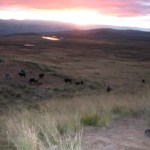


The Mountain Institute
Ecuador, Peru, and Bolivia
5/2019—5/2022
The project works in the highland grasslands environment (puna) of the Cordillera Blanca mountains of northern Peru. In pre-colonial times, this ecosystem supported llama and alpaca herds in the highlands (above 12,000 feet) and potato production in the lower areas. The Spanish introduced cattle, sheep, wheat and barley to the system. With land reform in the 1970s, the haciendas (Spanish-owned farms) were given back to the workers and worked on a communal basis. A large part of the highland area was designated as a national park. More recently, communities have been privatizing much of their communal land and young people have been migrating to lower elevations. The agroecology has been changing in parallel to the changing social conditions, exacerbating the difficulties faced by those who continue trying to produce their livelihoods in the region. Low availability of fodder during the dry season is one of the main causes of poor livestock production. This is due in part to the degradation of puna grassland, as well as to seasonality, which is changing as a consequence of climate change. The Mountain Institute (TMI) has conducted research on high Andean livestock systems in the Cordillera Blanca as part of CCRP’s regional CoP since 2009. Together with farmers, TMI has developed innovations to promote sustainable management of puna pastures above 12,000 feet. Over the past nine years, they have identified innovations, such as improved forage varieties, livestock management, and silage production, which could promote sustainable grassland management. Different options are proposed for various social and environmental contexts, such as private versus communally managed grasslands. They have also studied the connections between grassland management and above- and below-ground water quantity and quality.
TMI and partners continue to provide knowledge and alternatives to decision-makers (communities, rural households and policy makers) about strategies to support the implementation of agroecological intensification (AEI) of the landscapes of the high Andes. Together, TMI staff, students from the local university, and local community members will test innovations for grassland management. The project will, for the first time, do a participatory contextual analysis of the cropping lands below the grasslands.
Specifically, the project plans to: 1) understand the historical context and contemporary drivers of change in the lower areas (contexts); 2) evaluate the social, environmental, and production impacts of innovations in livestock and grassland management to promote context-appropriate AEI solutions (options); and 3) engage community partners, government agencies, and other CCRP projects to identify and implement strategies to promote policies and actions that support agroecological intensification of agro-pastoral systems in the Andes (matching options and contexts); as well as to further the global discussion about the role of livestock in agroecological systems.
